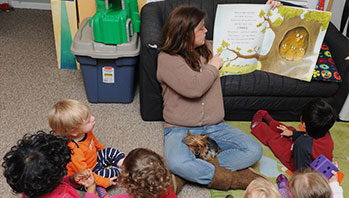- carrot seeds (or other seeds)
- paper bag
- garden
- ground
- grow
- plant
- seed
- sprinkle
MA Standards:
Literature/RL.PK.MA.1: With prompting and support, ask and answer questions about a story or a poem read aloud.
Literature/RL.PK.MA.4: With prompting and support, ask and answer questions about unfamiliar words in a story or poem read aloud.
Literature/RL.PK.MA.9: With prompting and support, make connections between a story or poem and one’s own experiences.
Literature/RL.PK.MA.10: Listen actively as an individual and as a member of a group to a variety of age-appropriate literature read aloud.
Head Start Outcomes:
Literacy Knowledge/Book Appreciation and Knowledge: Asks and answers questions and makes comments about print materials.
PreK Learning Guidelines:
English Language Arts/Reading and Literature 6: Listen to a wide variety of age appropriate literature read aloud.
English Language Arts/Reading and Literature 10: Engage actively in read-aloud activities by asking questions, offering ideas, predicting or retelling important parts of a story or informational book.
Read Together: The Carrot Seed

© Commonwealth of Massachusetts, Department of Early Education and Care (Jennifer Waddell photographer). All rights reserved.
STEM Key Concepts: Plants start in different ways; Some plants start from seeds; Plants need water, food, and sunlight to grow; Plants that grow in soil have some parts below the ground and some above.
ELA Focus Skills: Active Listening, Concepts of Print, Listening and Speaking, Predicting, Story Comprehension, Vocabulary
Shake a bag filled with carrot seeds and tell children the bag contains carrot seeds. Explain that the seed is the part of a plant that is able to grow into a new plant of the same kind. Say, Inside every seed is a plant ready to grow. Explain that many plants grow from seeds. Invite children to look at and feel the seeds. Ask them to describe their color, texture, shape, and size.
Before You Read
Show children the book cover and point to the boy and ask children what they think the boy is doing. (planting a seed.) Then ask them to point to the title. Read the title aloud and tell children it is a story about a boy who plants a seed. Then ask questions such as,
- Have you ever planted seeds or helped someone at home plant seeds? (Invite them to describe this experience.)
- What do you think will grow from the seed the boy plants? (carrot) Why do you think that? (planted a carrot seed)
As You Read
Read slowly and with expression. As you read, ask children to notice all the things the boy does to take care of his plant.
Act out the motions of digging with a shovel, planting the seed, pulling up the weeds, sprinkling the ground with water, and pushing the wheelbarrow. Pause occasionally to ask questions. For example:
- Pause after the brother says “It won’t come up.” Ask, Did you wonder if your seed would grow? Why didn’t you think so?
- Pause after you read, “But he still pulled up the weeds around it every day and sprinkled the ground with water.” Point to the watering can and ask, Does the boy think the carrot will come up? How do you know?
- Explain to children that weeds are plants that people don’t want in their garden. (The boy is planting a carrot seed so he doesn’t want any other plants in his garden.)
After You Read
Talk about the book with children. Ask questions such as:
- What are all the things the boy does to help the seed grow?
- Why do you think the boy was so sure the carrot would come up?
- Discuss how the boy kept watering the carrot even though his family told him it wouldn’t come up.
- You may point out the boy’s perseverance in taking care of the plant even when he does not see any growth. Ask, Have you ever kept trying something even when other people told you it wouldn’t work?
English Language Learners: Demonstrate the word grow for children by having them crouch down to the ground with you and slowly rise up. Say, When something grows it gets bigger. Plants grow up.
